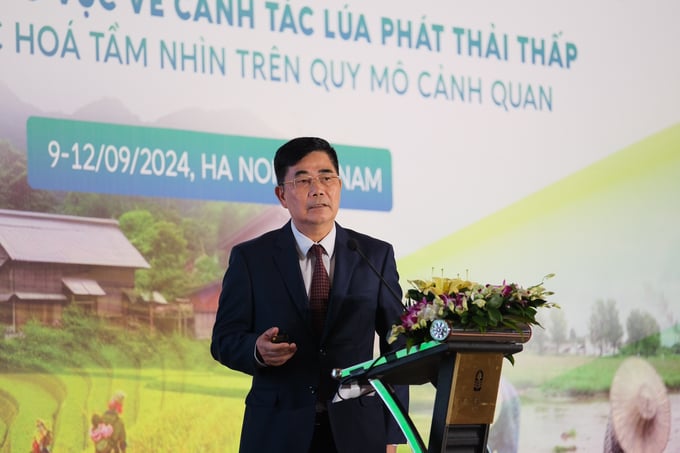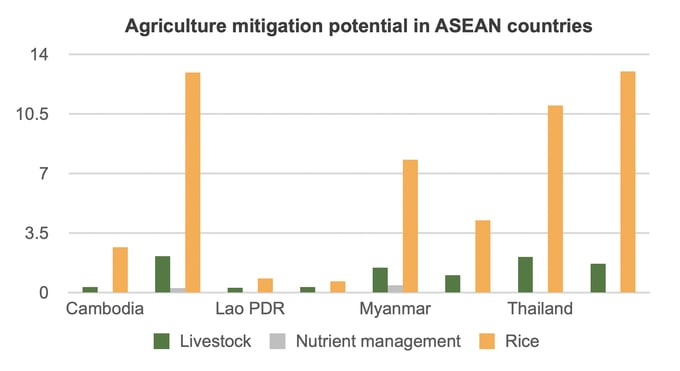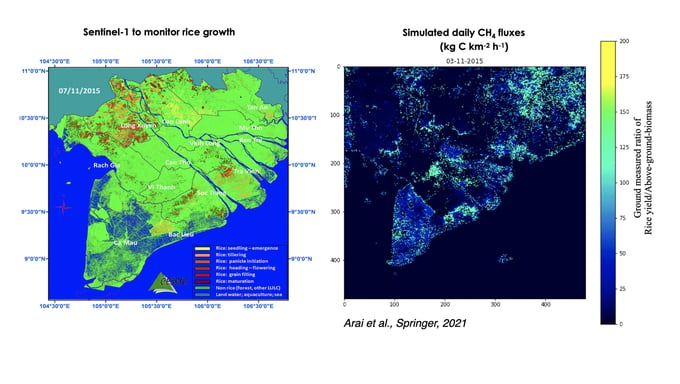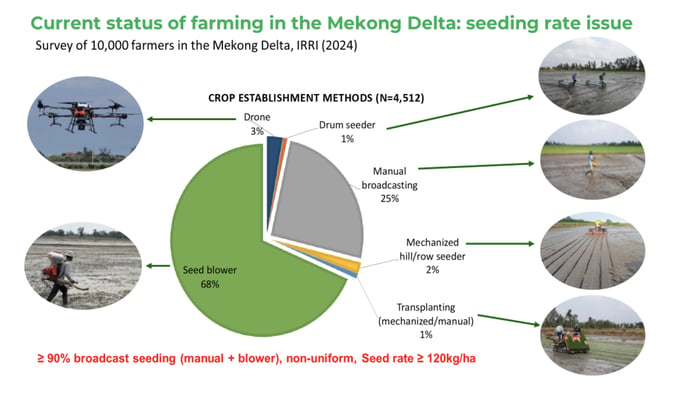May 30, 2025 | 10:37 GMT +7
May 30, 2025 | 10:37 GMT +7
Hotline: 0913.378.918
May 30, 2025 | 10:37 GMT +7
Hotline: 0913.378.918

Dr. Cao Duc Phat introduces global rice landscapes and Vietnam's experience with low-emission rice. Photo: Quynh Chi.
The global rice landscape is vast, covering approximately 165 million hectares as of 2022, with an average yield of 4.7 tons per hectare, resulting in a total production of 776 million tons of paddy rice annually. This staple crop is crucial for nearly half of the world’s population, predominantly in Asia, where 75-80% of both production and consumption occur across eight key countries.
However, the rice supply chain is fragmented, predominantly involving smallholder farmers, leading to volatile supply chain margins and often slim farmer margins. Approximately 75% of white rice is directly consumed, with the remaining 25% processed into value-added products, and about 8-10% traded internationally, with major exporters including India, Thailand, and Vietnam.
Despite its significance, rice cultivation poses substantial environmental challenges, particularly concerning GHG emissions. In 2021, the agrifood system accounted for 16% of global emissions, with rice alone contributing 37% of these emissions. The emission intensity of rice cultivation is notably high, at approximately 1.0414 kg CO2 equivalent per kilogram of paddy rice, making it the third-largest source of non-CO2 GHG emissions in agriculture, after livestock and all croplands according to the EPA (2021).
The main challenges facing rice production include food insecurity in many rice-growing countries, low incomes for rice farmers, and the overall unsustainability of current practices. Rice cultivation is also highly vulnerable to climate change impacts, exacerbating emission issues and threatening global food security.
However, there are opportunities for improvement through new technologies such as biotechnology and digital advancements, policy reforms to promote sustainable practices, increased investment in agricultural innovation, and strengthened international cooperation to address shared challenges in rice production and environmental sustainability.
The agriculture sector presents significant mitigation potential, particularly in rice cultivation, which accounts for 36% of the sector’s mitigation potential compared to livestock (9%) and other croplands (3%).

Irrigated paddy rice production, in particular, offers one of the most promising avenues for reducing emissions within agriculture. In Southeast Asia, emissions from rice cultivation are notably higher than those from livestock or other crops, largely due to the traditional method of flooded paddy farming. This method releases high levels of methane and other GHG through anaerobic decomposition in waterlogged fields.
To address these challenges, there are opportunities for climate finance and existing methodologies for carbon markets in the rice sector, such as the Clean Development Mechanism (CDM), Gold Standard, Thailand’s T-VER, and mechanisms under Article 6 of the Paris Agreement. The effectiveness and value of climate financing, as well as monitoring, reporting, and verification (MRV) of emission reductions, vary based on the intended use, scale, and market conditions.
Potential emission reductions in rice production can be substantial with the adoption of specific practices: up to 10% reduction can be achieved by timing residue incorporation and managing pre-season flooding, up to 7% by planting short-duration rice varieties, and an average of 33% reduction through practices like alternate wetting and drying (AWD) and efficient fertilizer use. Additionally, leaving less crop residue after harvest and avoiding straw burning can cut emissions by up to 15%. Innovative approaches such as mushroom production for nutritious and profitable outputs and mechanized composting to produce organic fertilizer offer further opportunities.
Implementing these low-emission initiatives requires comprehensive knowledge of current farming practices and accurate emission calculations. Farmers also need information on emission-reducing practices specific to rice production, along with the capacity to monitor, report, and verify changes in their practices. Lastly, financing is critical to support low-emission rice projects and to drive broader sector transformation towards sustainability.
IRRI plays a pivotal role in advancing sustainable rice production through a series of targeted research flagships aimed at addressing key challenges in nutrition, production, and climate resilience. One of IRRI’s primary focus areas is improving the nutritional quality of rice by developing varieties with a lower glycemic index and higher levels of essential nutrients like zinc, iron, and beta-carotene, thereby enhancing the health benefits of this staple food for millions.
IRRI’s Direct Seeded Rice (DSR) initiative is another critical flagship program, aimed at developing high-yielding, stress-tolerant rice varieties suited for direct-seeding conditions. This approach reduces the need for traditional transplanting methods, significantly cutting water use, agronomic inputs, and greenhouse gas emissions. DSR also lowers labor and irrigation costs, shortens crop cycles, and enables the possibility of producing more crops per year, enhancing both sustainability and farm income.
In response to the challenges posed by climate change, IRRI has introduced innovative solutions such as Climate-Smart Mapping of Risks and Adaptation Plans (CSMAP). This tool is designed to aid decision-makers at both local and central government levels by localizing climate-related risks and facilitating the participatory development of adaptation plans tailored to specific regions.
Remote sensing and modeling-based GHG quantification

Remote sensing and modeling-based GHG quantification. Photo: IRRI.
For GHG mitigation in rice cultivation, IRRI promotes Alternate Wetting and Drying (AWD), a water-saving technology that alternates between flooded and non-flooded field conditions. By applying irrigation water only after the disappearance of ponded water, AWD reduces water use without sacrificing yield, thereby helping farmers lower their GHG emissions and contribute to more sustainable rice production. This approach not only addresses environmental concerns but also supports farmers in adopting more resilient and cost-effective farming practices.
Vietnam’s rice sector faces several challenges, including low production efficiency, low incomes for farmers, and significant environmental issues such as pollution, GHG emissions, and vulnerability to climate change.
To address these challenges, Vietnam aims to transform its rice sector by focusing on high value-added production, improving farmers’ livelihoods, enhancing sustainability, and achieving low emissions. The main measures to achieve these goals include continued policy reform, the advancement of science, technology, and innovation, infrastructure development, human resource development, and better governance.
A key initiative driving this transformation is the Program for Sustainable Development of One Million Hectares of High-Quality and Low-Emission Rice in the Mekong Delta by 2030. This ambitious program targets one million hectares, engaging over one million farming households.
The program aims to reduce seed use to 70kg per hectare and cut chemical fertilizers and pesticide use by 30%. It also seeks to implement sustainable rice intensification (SRI), the “One Must, Five Reductions” (1M5R) approach, and AWD on 100% of the targeted area, along with the collection of 100% of rice residues. The expected outcomes include a reduction in emissions by over 10%, a 40% increase in value-added, and a 50% rise in farmers’ profits.

The success of the program is already evident in pilot projects in Can Tho, where significant achievements have been made: seed use has been reduced by 60kg per hectare (a 50% reduction), nitrogen fertilizer use has decreased by 30 kg per hectare (a 25% reduction), and GHG emissions have been cut by 2 tons CO2 equivalent per hectare (a 40% reduction compared to continuous flooding and straw removal practices). Additionally, average yields have increased by 1.2 tons per hectare (23-25%), leading to higher incomes of approximately USD 300 per hectare per crop (a 20-30% increase).
However, scaling up these successes presents new challenges. To broaden the impact, there is a need for more effective technical packages, enhanced farmer education, improved infrastructure, better marketing and market incentives, financial support, and stronger institutional frameworks, including the development of farmer organizations.
Addressing these challenges will be crucial for the broader adoption of sustainable and low-emission practices across Vietnam’s rice sector, ultimately contributing to green growth and improved resilience in the face of climate change.
/2025/05/25/4127-3-073637_820.jpg)
(VAN) Thanks to the promotion from an FAO-implemented project, vegetable production in greenhouses in Moc Chau has seen strong development, from 1.5 hectares in 2021 to nearly 50 hectares in 2024.

(VAN) FAO has recently supported USD 140,000 to implement the project 'Risk mitigation human-animal interface risks through disease control initiatives in pig farming.'

(VAN) The People's Committee of Tra Vinh province has approved an adjustment to the investment policy for the Green Hydrogen Plant project, increasing its area to approximately 52.76 hectares.
![Reducing emissions from rice fields: [2] Farmers’ commitment to the soil](https://t.ex-cdn.com/nongnghiepmoitruong.vn/608w/files/news/2025/05/05/dsc08881jpg-nongnghiep-140632.jpg)
(VAN) Clean rice cultivation model in Thuong Tan commune, Bac Tan Uyen district, is assisting local residents in achieving sustainable agriculture by substantially reducing costs, increasing productivity, and protecting the environment.

(VAN) At the conference to disseminate Resolution No. 68, AgriS introduced its digital agricultural ecosystem and reaffirmed its commitment to accompanying the Government in promoting private sector development and sustainable agriculture.

(VAN) 'Blue Ocean - Blue Foods' initiative is designed to restore marine ecosystems and establish sustainable livelihoods for local communities by cultivating a minimum of 1,000 hectares of cottonii seaweed in the first three years.
/2025/05/21/4642-3-112707_603.jpg)
(VAN) The V-SCOPE project has made direct contributions to three out of six pillars of the Comprehensive Strategic Partnership between Vietnam and Australia.